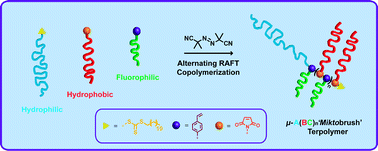Block polymers can spontaneously self-assemble into well-defined nanostructures in block selective solvents and in the bulk, offering a powerful ‘bottom up’ approach towards precisely engineered materials for many diverse applications including; microelectronics, tissue engineering, drug delivery and water purification. The increased understanding of self-assembled block polymers with varied architectures is of both fundamental and technological importance. Towards this goal, AB diblock copolymers have been studied in depth and it has been shown that adding more blocks and functional groups increases architectural and functional complexity and can lead to more exotic self-assembled morphologies.
In this study, Lodge and Hillmyer reported an innovative synthetic strategy towards a wide compositional range of structurally well defined “miktobrush” block terpolymers, m-A(BC)n obtained using rather mild and facile reaction conditions with three separate polymer building blocks. The copolymers were synthesized utilizing the alternating radical copolymerization of two hydrophobic and incompatible macromonomer (MM) building blocks; a maleimide (MI) end functionalized poly(methyl-caprolactone) block (MI-PMCL) or ‘C’ and a styrene (Sty) end functionalized poly(perfluoro propylene oxide) block (Sty-PFPO) or ‘F’. Polymerizations were mediated by a poly(ethylene oxide) (PEO) functionalized reversible addition–fragmentation chain transfer (RAFT) agent (PEO–CTA) or ‘O’ to control the chain growth of the MMs from the O block to form O(CF)n “miktobrush” terpolymers. The synthesis of a range of well defined m-O(CF)n terpolymers with various compositions was achieved by simply changing the feed of MMs. This new strategy offers a powerful route towards a block polymer architecture that can enable the formation of multi-domain hierarchical nanostructures with features on multiple length scales due to the incompatibility and unique connectivity of the building blocks incorporated.
Synthesis of block polymer miktobrushes by Adam O. Moughton, Takanori Sagawa, William M. Gramlich, Myungeun Seo, Timothy P. Lodge, and Marc A. Hillmyer, Polym. Chem., 2013, 4, 166-173.
Julien Nicolas is a guest web-writer for Polymer Chemistry. He currently works at Univ. Paris-Sud (FR) as a CNRS researcher











